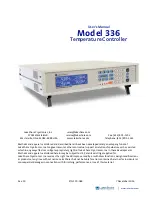
46
TROUBLESHOOTING GUIDE
Troubleshooting
FAULT
POSSIBLE CAUSE
FIX
A RELAY CLICK IS HEARD WHEN
GIVEN A COMMAND SLIGHTLY
BEFORE MOTOR MOVEMENT.
RELAY LED'S ON BOARD FLASH
IN UNISON WITH THE CLICK.
This is normal operation.
³
No action necessary. See Logic Board Overview (page 27) for more
information regarding current sense.
THE OPERATOR WILL NOT
RESPOND TO ANY COMMANDS.
a) No power supply.
³
A) Make sure power is connected to the L1, L2 and L3 terminals.
B) Check the motor harness and ensure the motor harness is connected to the
correct power connector.
C) Check the transformer.
b) Control station not connected
or wired correctly
³
Use the OPEN, CLOSE and STOP LEDs to help check for correct wiring.
Verify the board is accepting commands by using the onboard station. The
green LED next to stop button must be illuminated.
c) Interlock switch is activated.
³
Check Interlock(s). If more than one external interlock is present they must be
wired in series. Green LED next to stop button must be on.
d) Selector dial still in PROG,
OPTN, or DIAG mode.
³
Set selector dial to the desired wiring type.
e) Motor is malfunctioning.
³
Verify proper voltage is being delivered to the motor (Check motor name
plate).
f) Motor thermal overload is
tripped.
³
Check to see if motor is hot. Allow motor to cool before attempting to move
door. Cycle operator in constant pressure one full cycle. (OPEN and CLOSE to
reset fault)
g) Possible malfunction of an
accessory.
³
Disconnect all devices, reattach one at a time testing for a
failure after each one is replaced.
h) Power Board may need to be
replaced.
³
When the OPEN or CLOSE button is pressed, Relay A or B LED
should illuminate and the door should move in the corresponding
direction. If Relay A or B illuminates and the door does not move, the
Power Board may need to be replaced.
i) Possible logic board failure.
³
Replace logic board.
POWER LED IS NOT
ILLUMINATED.
a) Loose secondary wiring
connections or a faulty control
transformer.
³
Repair or replace connections or control transformer.
b) Hoist interlock switch engaged.
³
Check interlock. Verify the manual release chain is not engaged.
STOP BUTTON LED IS NOT
ILLUMINATED.
a) Control station not connected
or wired correctly.
³
Check wiring to control station.
b) Malfunctioning interlock switch.
³
Check interlock switch(es) for continuity.
THE DOOR WILL MOVE ABOUT A
FOOT AND STOPS. AFTER
STOPPING, ONLY CONSTANT
PRESSURE COMMANDS WILL
MOVE THE DOOR.
a) RPM sensor is not connected
properly or is malfunctioning.
³
Check the RPM assembly for loose connections. Make sure the interrupter cup
is turning when operator is running. Check for foreign matter blocking.
³
Replace RPM sensor.
b) Clutch is slipping.
³
Adjust clutch and verify the door is not binding.
THE DOOR WILL MOVE MOST OF
THE WAY TOWARDS A LIMIT
AND STOP. AN ADDITIONAL
OPEN OR CLOSE COMMAND IS
ABLE TO GET DOOR TO
COMPLETE CYCLE
.
The Maximum Run Timer is not
set correctly.
³
Manually reprogram the Maximum Run Timer (page 43) or reset the factory
defaults (page 43).
THE DOOR WILL OPEN SOME
BUT NOT COMPLETELY. AN
EXTRA OPEN IS ABLE TO GET
THE DOOR TO OPEN
COMPLETELY.
A Mid-Stop may be set.
³
Check to see if the Mid-Stop LED is on. Clear the Mid-Stop by turning the
selector dial to PROG. Press and hold the MID-STOP button for 5 seconds.
Return selector dial to desired wiring type.
THE DOOR WILL OPEN BUT WILL
ONLY CLOSE AFTER A FIVE
SECOND DELAY WITH
CONSTANT PRESSURE ON THE
CLOSE BUTTON (RESTRICTED
CLOSE MODE).
a) The LMEP attached is
obstructed or activated.
³
If the on board LMEP LED is flashing, the photoelectric sensors are misaligned
or not connected. Remove any obstructions, check the entrapment protection
device wires for continuity and shorts. If more than one LMEP is installed with
the use of a CPS3CARD the LMEP will not flash when one of the LMEP’s is
blocked.
b) The logic board thinks the direct
connect photoelectric sensors
are attached and blocked.
³
Unlearn the photoelectric sensors from the memory by resetting factory
defaults.
















































